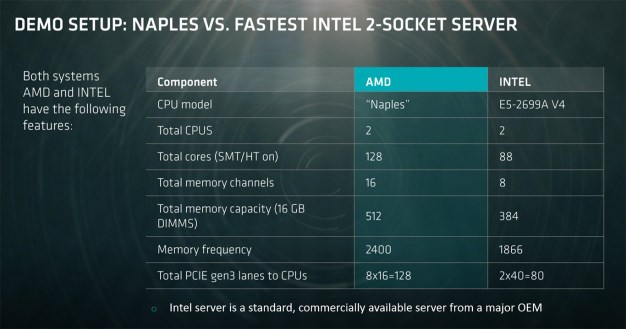AMD Poised To Disrupt The Data Center With Zen-Based Naples Platform
AMD Claims Naples Smokes Intel Xeon Platform Performance
AMD’s performance comparisons at its tech day event pit a 2P Naples server, with 512GB of DDR4 RAM, up against a 2P Intel Xeon E4-2699A V4 configuration with 384GB of RAM.
The comparison table above shows how the systems stacked up in a few other ways. The Naples system had a higher memory capacity, and that memory was clocked much higher too – 2400MHz vs. 1866MHz. The Naples system has more cores, and with SMT on, can ultimately process more threads as a result. The AMD Naples system also has double the memory channels, further improving peak memory bandwidth, and 48 additional lanes of PCI Express connectivity available.
The comparison table above shows how the systems stacked up in a few other ways. The Naples system had a higher memory capacity, and that memory was clocked much higher too – 2400MHz vs. 1866MHz. The Naples system has more cores, and with SMT on, can ultimately process more threads as a result. The AMD Naples system also has double the memory channels, further improving peak memory bandwidth, and 48 additional lanes of PCI Express connectivity available.
The Naples processors’ frequency wasn’t given, but we know now that the Zen core can offer comparable IPC to Intel’s Broadwell architecture with many workloads, so if AMD can get clocks in-line with Intel’s many-core Xeons, AMD could have a significant multi-threaded advantage in many applications, in addition to much more memory bandwidth.
In its performance demos, AMD used a seismic analysis workload, which involved multiple iterations of 3D wave equations. According to AMD, the test taxes the entire system, including CPU cores, memory and I/O. This type of workload is used to locate natural resource deposits and is representative of many technical, enterprise workloads.
In the first comparison, some of the cores in the AMD system were disabled, so there were an equal amount in each setup – 44 cores / 88 threads available in each system. The memory was clocked down to 1866MHz in the AMD setup to match the Intel server as well. The test used a 1 billion sample grid and performed 10 iterations of the wave equations. The AMD system completed the test almost 2x faster than the Intel setup.
In the second demo, which used the same sample grid, all of the cores were enabled in the AMD rig and its memory was clocked up to 2400MHz. This time around the AMD system completed the equations roughly 2.5x faster than the Intel Xeon server.


And in the final demo, AMD used a much larger dataset consisting of a 4 billion sample grid, which exceeded the memory capacity of the Intel server. In the real world, data would be sliced, chunked, and processed as necessary to accommodate available memory capacity, but AMD performed this test to show that its platform will have more memory capacity, which will technically allow it work on larger datasets that Intel's Xeon at a base level.
These tests were clearly bandwidth constrained, which is why the AMD platform – with double the memory channels and faster memory to boot – was able to complete them so much faster than Intel. With other workloads, the difference isn’t likely to be as stark, but we know Zen has similar IPC performance to Broadwell-E, so with more memory bandwidth and processor cores, AMD Naples performance prospects look very good.
Of course, AMD has additional processors on the way as well – namely Radeon Instinct GPUs. Because of all of the available PCIe connectivity in Naples, full bandwidth will be available to link up the GPUs, without using any PCI Express switches. AMD claims a Naples server with four Radeon Instinct cards has the "computing power of a human brain."
Expected price points weren’t given, but Naples processors and servers should be available in Q2. Representatives from AMD did say the company was planning to take a similar approach in the server space as they have with Ryzen in the consumer market, so we expect the company to put some pricing pressure on Intel as availability ramps-up.











